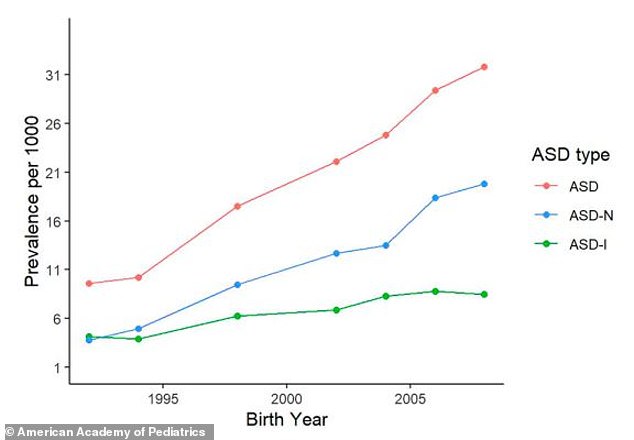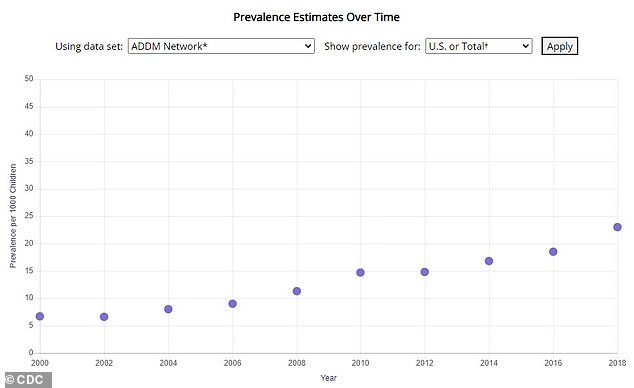Have autism rates really tripled in the US or are doctors just getting better at spotting it?
>
The number of children with autism has tripled in 16 years, raising questions about whether the condition is becoming more common.
A study by researchers from Rutgers University found that between 2000 and 2016, the rate of Autism Spectrum Disorder (ASD) among under-8s increased from around 10 per 1,000 to around 30 per 1,000 within the metropolitan area of New Jersey and New York.
A similar rise has been seen nationally – with rates increasing from one in 150 in 2000 to one in 54 in 2016.
There is currently still no standard medical test for autism, but there have been big steps forward in diagnostic capabilities, as well as a greater understanding of the disorder, which seem to be at least partly driving the increase.
The number of children with autism has tripled in 16 years, raising questions about whether the condition is becoming more common (file image)

The graph above from the new Rutgers study shows autism prevalence estimates per 1,000 eight-year-old children in New Jersey overall and by intellectual ability. The proportion of eight-year-olds diagnosed with autism who do not have intellectual disabilities rose more steeply (shown by the blue line) than those who do not (shown by the green line)
The study, published in the journal Pediatrics, found that the proportion of eight-year-olds diagnosed with autism who do not have intellectual disabilities rose more steeply than those who do not – fivefold compared to twofold between 2000 and 2016.
The Rutgers team said the main reasons were advances in diagnosing, particularly in identifying autism without intellectual disabilities.
This refers to children with an average or higher than average IQ and autistic traits such as trouble socializing, communicating, and doing the same things over and over. These cases of autism might be harder to spot.

National autism rates in America have increased over time. Rates increased from one in 150 children diagnosed with autism by the age of eight in 2000 to one in 54 in 2016, according to CDC data
However, researchers are clear that the rise in prevalence of autism has nothing to do with vaccines.
Santhosh Girirajan, associate professor at Pennsylvania State University, told NBC News: ‘We know for sure, for so many years now, that vaccines don’t cause autism.’
Other reasons for the rise include genetic and environmental factors, but the precise cause is unknown.
Numerous studies have shown that children born to older parents are more likely to have the disorder. Complications at birth also raise the risk.
The Rutgers study said universal autism screening at routine pediatric visits is needed to better identify cases of autism which are moderate to mild.
Because there is no standard test for the condition, doctors must rely on a child’s developmental history and behavior.
But experts say early intervention can make a huge difference, with early detection key in ensuring kids on the spectrum get the help they need.
To receive an official diagnosis, children must still see a trained professional, but the ASDQ questionnaire represents another step towards a standardized test for autism.
Screenings for ASD are advised at the 18-month and 24-month milestones, whereby the child’s language, movement, and thinking skills, as well as behaviors and emotions, are tracked against the rest of their age group.
Formal diagnosis, however, must be handled by a trained specialist such as a developmental pediatrician or child psychologist.
About one in 44 children in the US has autism, a number that continues to rise as the disorder is de-stigmatized.
Despite scientific and social advancements, however, autism is still often only diagnosed well into childhood.
While the average age of diagnosis in the US is four years old, in the UK it is even older, at six.
